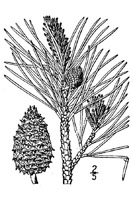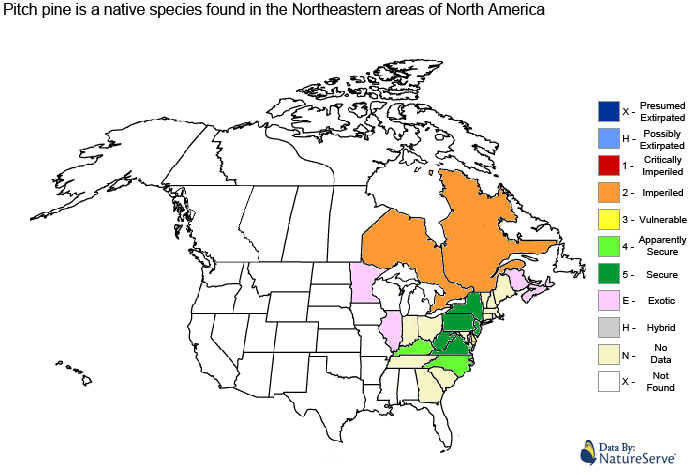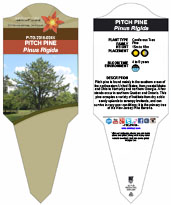Pitch pine is small to medium sized hard pine, native to Eastern North America. This species occasionally hybridizes with other pine species such as loblolly pine, short leaf pine, and pond pine. Pitch pine is found mainly in the southern areas of the northeastern United States, from coastal Maine and Ohio to Kentucky and northern Georgia. A few stands occur in southern Quebec and Ontario. This pine occupies a variety of habitats from dry acidic sandy uplands to swampy lowlands, and can survive in very poor conditions; it is the primary tree of the New Jersey Pine Barrens. Pitch pine is part of a series of trees which live in a fire dependant ecosystem. The latin name of the pitch pine is derived from pinus which is the latin word for 'pine' and rigida which is the latin word for 'rigid' which describes the trees hard and resilient properties.
Pitch pine is used principally for rough lumber and pulpwood for paper production.
Within the realm of rational and holistic medicine, pitch pine was not used as a source of food or medicine. The principle historic use of pitch pine was for the a major source of pitch and timber for ship building, mine timbers, and railroad ties because the wood's high resin content preserves it from decay. Pitch pine resin was also a major source for the manufacture of turpentine.
Please note that MIROFOSS does not suggest in any way that plants should be used in place of proper medical and psychological care. This information is provided here as a reference only.
There is currently no information on the edibility of the bark, seeds, needles, roots, or sap from the pitch pine tree.

The pitch pine has a life span of approximately 200 years and within that time can grow to be 15m to 18m tall. The needles are in fascicles of three, about 7.5cm to 13cm long, and are over 1 mm thick. The needles are usually straight but can also be slightly twisted. The seed cones are 3cm to 7cm long and are egg shaped with prickles on the scales. Pitch pine has an exceptionally high regenerative ability; if the main trunk is cut or damaged by fire it can re-sprout using epicormic shoots. This is one of its many adaptations to fire, which also includes a thick bark to protect the sensitive cambium layer from heat. Burnt trees often form stunted, twisted trees with multiple trunks as a result of the resprouting. This characteristic also makes it a popular species for bonsai. Pitch pine is rapid-growing when young, gaining around one foot of height per year under optimal conditions until the tree is 50 to 60 years old, whereupon growth slows. By 90 years of age, the amount of annual height gain is minimal. Open-growth trees begin bearing cones in as little as three years, with shade-inhabiting pines taking a few years longer. Cones take two years to mature and seed dispersal occurs over the fall and winter and trees cannot self-pollinate.
| Tree Height |
15m to 18m |
| Habitat |
Sands and gravel on ridges or within swamps and valleys |
| Needle Length |
7.5cm to 13cm long |
| Needle Grouping |
Stout Bundles of Three |
| Needle Colour |
Yellow and Green |
| Bark |
Thick, Rough, and broadly furrowed into broad scaly ridges |
| Bark Colour |
Dark Gray |
| Cone Size |
3cm to 7cm long and egg shaped |
| Cone Colour |
Yellowish Brown |
| Pollination |
Wind |
| Tree Gender |
Trees are hermaphrodite trees are not self-fertile |
| Fruit |
Small winged seeds |
| USDA Zone |
3 (-37°C to -40°C) cold weather limit |
No known health risks have been associated with pitch pine. However ingestion of naturally occurring plants without proper identification is not recommended.
 |
-Click here- or on the thumbnail image to see an artist rendering, from The United States Department of Agriculture, of pitch pine. (This image will open in a new browser tab) |
 |
-Click here- or on the thumbnail image to see a magnified view, from The United States Department of Agriculture, of the seeds created by the pitch pine tree for propagation. (This image will open in a new browser tab) |
Pitch pine can be referenced in certain current and historical texts under the following two names:
Pitch pine can be translated into the following select languages:
| Arabic |
الصنوبر الملعب |
Bulgarian |
смолист бор |
Chinese (Sim) |
间距松 |
| Croatian |
smoloviti bor |
Czech |
borovice bahenní |
Danish |
|
| Dutch |
Amerikaans grenehout |
Esperanto |
tonalton pino |
Estonian |
pigi mänd |
| Finnish |
piki mänty |
French |
pitchpin |
German |
|
| Greek |
πίσσα πεύκου |
Hebrew |
אורן המגרש |
Hungarian |
hangsíp |
| Italian |
|
Japanese |
ピッチ松 |
Korean |
송진을 채취 할 수있는 소나무 |
| Low Saxon |
|
Lithuanian |
pikio pušies |
Norwegian |
|
| Persian |
زمین کاج |
Polish |
boisko sosny |
Portuguese |
|
| Romanian |
pin rășinos american |
Russian |
смолистая сосна |
Slovak |
borovica bahenná |
| Spanish |
pino |
Swedish |
|
Tagalog |
|
| Turkish |
çıralı çam |
Ukrainian |
смолистая сосна |
Vietnamese |
sân thông |
| The information provided in this conservation assessment has been provided by the Natureserve Database in conjuction with various federal, provincial, state, county, district, regional, and municipal governments as well as public and private conservation authorities. Information in this section is accurate from the last time this article was updated. |
 |
Pitch pine is a secure native species in North America. |

| Description |
Moore, Gerry; Kershner, Bruce et al. (2008). National Wildlife Federation Field Guide to Trees of North America. New York: Sterling. ISBN 1-4027-3875-7 |
| Description |
Collingwood, G. H., and W. D. Brush. 1978. Knowing your trees. Rev. and ed. by D. Butcher. American Forestry Association. Washington, DC. |
| Description |
Eyre, F. H. 1980. Forest cover types of the United States and Canada. Society of American Foresters. Washington, DC. |
| Biology |
Dickinson, R.; Royer, F.; (2014) Plants of Southern Ontario. ISBN 978-1-55105-906-8. |
| Image Rendering |
USDA-NRCS PLANTS Database / USDA NRCS. Wetland flora: Field office illustrated guide to plant species. USDA Natural Resources Conservation Service. |
| Environment |
National Audubon Society. Field Guide To Trees (Eastern Region): Alfred A. Knopf. ISBN 0-394-50760-6 |
| Physical Identification |
National Audubon Society. Field Guide To Trees (Eastern Region): Alfred A. Knopf. ISBN 0-394-50760-6 |
| August 01, 2015 |
The last time this page was updated |
| ©2021 MIROFOSS™ Foundation |
 |
Powered By Dynamo™ |
|




















